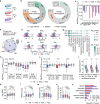O-GlcNAcylation reduces proteome solubility and regulates the formation of biomolecular condensates in human cells
- PMID: 40307207
- PMCID: PMC12043995
- DOI: 10.1038/s41467-025-59371-4
O-GlcNAcylation reduces proteome solubility and regulates the formation of biomolecular condensates in human cells
Abstract
O-GlcNAcylation plays critical roles in the regulation of protein functions and cellular activities, including protein interactions with other macromolecules. While the formation of biomolecular condensates (or biocondensates) regulated by O-GlcNAcylation in a few individual proteins has been reported, systematic investigation of O-GlcNAcylation on the regulation of biocondensate formation remains to be explored. Here we systematically study the roles of O-GlcNAcylation in regulating protein solubility and its impacts on RNA-protein condensates using mass spectrometry-based chemoproteomics. Unexpectedly, we observe a system-wide decrease in the solubility of proteins modified by O-GlcNAcylation, with glycoproteins involved in focal adhesion and actin binding exhibiting the most significant decrease. Furthermore, O-GlcNAcylation sites located in disordered regions and with fewer acidic and aromatic residues nearby are related to a greater drop in protein solubility. Additionally, we discover that a specific group of O-GlcNAcylation events promotes the dissociation of RNA-protein condensates under heat stress, while some enhance the formation of RNA-protein condensates during the recovery phase. Using site mutagenesis, inhibition of O-GlcNAc transferase, and fluorescence microscopy, we validate that O-GlcNAcylation regulates the formation of biocondensates for YTHDF3 and NUFIP2. This work advances our understanding of the functions of protein O-GlcNAcylation and its roles in the formation of biomolecular condensates.
© 2025. The Author(s).
Conflict of interest statement
Competing interests: The authors declare no competing interests.
Figures






Similar articles
-
O-GlcNAcylation regulates integrin-mediated cell adhesion and migration via formation of focal adhesion complexes.J Biol Chem. 2019 Mar 1;294(9):3117-3124. doi: 10.1074/jbc.RA118.005923. Epub 2018 Dec 26. J Biol Chem. 2019. PMID: 30587575 Free PMC article.
-
Deciphering the Functions of O-GlcNAc Glycosylation in the Brain: The Role of Site-Specific Quantitative O-GlcNAcomics.Biochemistry. 2018 Jul 10;57(27):4010-4018. doi: 10.1021/acs.biochem.8b00516. Epub 2018 Jul 2. Biochemistry. 2018. PMID: 29936833 Free PMC article.
-
O-Linked-N-Acetylglucosaminylation of the RNA-Binding Protein EWS N-Terminal Low Complexity Region Reduces Phase Separation and Enhances Condensate Dynamics.J Am Chem Soc. 2021 Aug 4;143(30):11520-11534. doi: 10.1021/jacs.1c04194. Epub 2021 Jul 25. J Am Chem Soc. 2021. PMID: 34304571
-
MS-based proteomics for comprehensive investigation of protein O-GlcNAcylation.Mol Omics. 2021 Apr 19;17(2):186-196. doi: 10.1039/d1mo00025j. Mol Omics. 2021. PMID: 33687411 Review.
-
Nutrient regulation of the flow of genetic information by O-GlcNAcylation.Biochem Soc Trans. 2021 Apr 30;49(2):867-880. doi: 10.1042/BST20200769. Biochem Soc Trans. 2021. PMID: 33769449 Review.
Cited by
-
Mealtime alters daily rhythm in nuclear O-GlcNAc proteome to regulate hepatic gene expression.bioRxiv [Preprint]. 2025 Jun 19:2024.06.13.598946. doi: 10.1101/2024.06.13.598946. bioRxiv. 2025. PMID: 40666963 Free PMC article. Preprint.
References
-
- Lafontaine, D. L. J., Riback, J. A., Bascetin, R. & Brangwynne, C. P. The nucleolus as a multiphase liquid condensate. Nat. Rev. Mol. Cell Biol.22, 165–182 (2021). - PubMed
MeSH terms
Substances
Grants and funding
- R01 GM118803/GM/NIGMS NIH HHS/United States
- R35 GM156318/GM/NIGMS NIH HHS/United States
- R35GM156318/U.S. Department of Health & Human Services | NIH | National Institute of General Medical Sciences (NIGMS)
- R01GM118803/U.S. Department of Health & Human Services | NIH | National Institute of General Medical Sciences (NIGMS)
LinkOut - more resources
Full Text Sources
Miscellaneous

